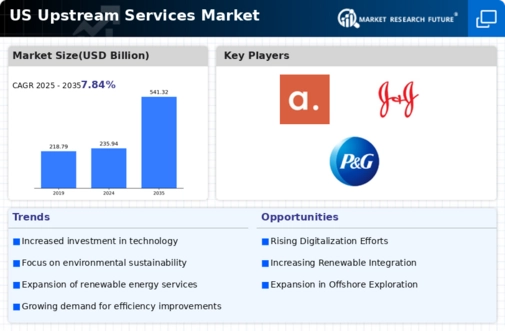The upstream services market is currently characterized by a competitive landscape that is both dynamic and multifaceted. Key growth drivers include the increasing demand for energy, technological advancements, and a heightened focus on sustainability. Major players such as ExxonMobil (US), Chevron (US), and BP (GB) are strategically positioning themselves through innovation and partnerships. For instance, ExxonMobil (US) has been investing heavily in digital transformation initiatives to enhance operational efficiency, while Chevron (US) is focusing on expanding its renewable energy portfolio, indicating a shift towards more sustainable practices. Collectively, these strategies are reshaping the competitive environment, pushing companies to adapt to evolving market demands.
In terms of business tactics, companies are increasingly localizing their operations and optimizing supply chains to enhance resilience and responsiveness. The market structure appears moderately fragmented, with a mix of large multinational corporations and smaller regional players. The collective influence of key players is significant, as they drive technological advancements and set industry standards, thereby shaping the overall market dynamics.
In October 2025, Chevron (US) announced a strategic partnership with a leading technology firm to develop AI-driven solutions for predictive maintenance in its upstream operations. This move is likely to enhance operational efficiency and reduce downtime, reflecting a broader trend towards digitalization in the sector. Such initiatives not only improve productivity but also align with the industry's push towards sustainability by minimizing resource waste.
In September 2025, BP (GB) unveiled its ambitious plan to increase its investment in renewable energy projects by 30% over the next five years. This strategic pivot underscores BP's commitment to transitioning towards a low-carbon future, which is becoming increasingly critical in the current market landscape. By diversifying its energy portfolio, BP (GB) aims to mitigate risks associated with fossil fuel dependency and capitalize on the growing demand for cleaner energy solutions.
In August 2025, ExxonMobil (US) launched a new initiative aimed at reducing greenhouse gas emissions from its upstream operations by 25% by 2030. This initiative is indicative of the company's recognition of the importance of sustainability in maintaining its competitive edge. By proactively addressing environmental concerns, ExxonMobil (US) positions itself favorably in a market that is increasingly prioritizing eco-friendly practices.
As of November 2025, current competitive trends are heavily influenced by digitalization, sustainability, and the integration of advanced technologies such as AI. Strategic alliances are becoming more prevalent, as companies seek to leverage each other's strengths to enhance innovation and operational efficiency. Looking ahead, competitive differentiation is likely to evolve from traditional price-based competition to a focus on technological innovation, sustainability, and supply chain reliability. This shift suggests that companies that can effectively integrate these elements into their strategies will be better positioned to thrive in the increasingly complex upstream services market.














Leave a Comment